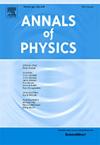拉斯托理论对承认复杂性消失的恒星解的启示:一个新的视角
IF 3
3区 物理与天体物理
Q2 PHYSICS, MULTIDISCIPLINARY
引用次数: 0
摘要
本文将复杂性因子的概念及其含义推广到非守恒拉斯托引力理论的框架中。首先,建立了与各向异性流体相关的静态球面几何的场方程。与所考虑的几何图形相对应的质量函数用物质量和几何量来定义。然后进行黎曼张量的正交分解,通过该分解得到一组标量,称为结构标量。使用Herrera最近的定义,其中的一个标量被称为复杂性因子,即YTF。由于引力方程中存在额外的自由度,因此需要一些约束才能使其解可能得到。在这方面,引入了一个众所周知的复杂性消失条件以及三个不同的约束,最终导致不同的恒星模型。为了检验它们的物理可行性,使用Rastall参数的多个值提供了详细的图形解释。结果表明,在这三种情况下得到的结果与广义相对论的结果一致。此外,拉斯托理论在模型2的情况下提供了更合适的结果,表明其优于爱因斯坦的引力理论。本文章由计算机程序翻译,如有差异,请以英文原文为准。
Implications of Rastall theory on stellar solutions admitting vanishing complexity: A new perspective
In this paper, the notion of complexity factor and its implication is extended to the framework of non-conserved Rastall theory of gravity. First of all, the field equations governing a static spherical geometry associated with the anisotropic fluid are formulated. The mass function corresponding to the considered geometry is defined in terms of both matter and geometric quantities. The orthogonal decomposition of the Riemann tensor is then performed through which a family of scalar quantities, known as structure scalars, is obtained. Using the Herrera’s recent definition, one of the scalars among them is claimed as the complexity factor, i.e., . Since there are extra degrees of freedom in the gravitational equations, some constraints are needed to make their solution possible to obtain. In this regard, a well-known vanishing complexity condition is introduced along with three different constraints which ultimately lead to distinct stellar models. In order to check their physical feasibility, a detailed graphical interpretation is provided using multiple values of the Rastall parameter. It is concluded that the obtained results in all three cases are consistent with those of general relativity. Further, the Rastall theory provides more suitable results in the case of model 2, indicating its superiority over Einstein’s gravity theory.
求助全文
通过发布文献求助,成功后即可免费获取论文全文。
去求助
来源期刊

Annals of Physics
物理-物理:综合
CiteScore
5.30
自引率
3.30%
发文量
211
审稿时长
47 days
期刊介绍:
Annals of Physics presents original work in all areas of basic theoretic physics research. Ideas are developed and fully explored, and thorough treatment is given to first principles and ultimate applications. Annals of Physics emphasizes clarity and intelligibility in the articles it publishes, thus making them as accessible as possible. Readers familiar with recent developments in the field are provided with sufficient detail and background to follow the arguments and understand their significance.
The Editors of the journal cover all fields of theoretical physics. Articles published in the journal are typically longer than 20 pages.
 求助内容:
求助内容: 应助结果提醒方式:
应助结果提醒方式:


